With the decline of the Mycenaean centres, Achaians from the Argolid came and settled here, founding important cities. The region is named Achaia after them. Though politically insignificant through most of an- tiquity, it started to play a more dynamic role in 280 BC, when the Achaian Confederacy was created. 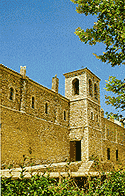 In 146 BC the area fell to the Romans. It embraced Christianity earlier than the rest of Greece (St. Andrew the Apostle preached in Patras and was martyred there). In 1205 it occupied centre stage with the founding of the Principality of Achaia by the Franks. Before too long it passed to the hands of the Palaiologues who ruled the Peloponnese from Mistra; they were succeeded by the Turks in 1460. For a short period (1687-1715), the area was a Venetian colony. It was liberated in 1828.
In 146 BC the area fell to the Romans. It embraced Christianity earlier than the rest of Greece (St. Andrew the Apostle preached in Patras and was martyred there). In 1205 it occupied centre stage with the founding of the Principality of Achaia by the Franks. Before too long it passed to the hands of the Palaiologues who ruled the Peloponnese from Mistra; they were succeeded by the Turks in 1460. For a short period (1687-1715), the area was a Venetian colony. It was liberated in 1828.
A trip to Patras Patras is the capital of the region or prefecture. It owes its name to Patreas, chief of the Achaians. The city is among the most important in Greece, and the largest in the Peloponnese. It is also a major transportation centre, linking the country with Italy and the Peloponnese with the lonian islands.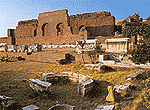 The city extends from the shore up to the Castle. It is divided into two parts, the upper and the lower, whose layout, parks and plazzas give it a definite distinction. The old city, at the foot of the castle, still has quite a number of attractive neoclassical houses, while the lower city has many mansions, such as those housing the Municipal Theatre, the Odeon, etc. The Cathedral of St. Andrew, the city's patron, rises majestically above the lower city. To the left of it stands an older church built on the site of a Byzantine church that was destroyed by the Turks. From here Trion Navarchon street leads to Psila Alonia - the "balcony" of Patras - a lovely spacious square with slender palm trees and a sun dial. Patras possesses a fine archaeological museum, an art gallery and a printing museum.
The city extends from the shore up to the Castle. It is divided into two parts, the upper and the lower, whose layout, parks and plazzas give it a definite distinction. The old city, at the foot of the castle, still has quite a number of attractive neoclassical houses, while the lower city has many mansions, such as those housing the Municipal Theatre, the Odeon, etc. The Cathedral of St. Andrew, the city's patron, rises majestically above the lower city. To the left of it stands an older church built on the site of a Byzantine church that was destroyed by the Turks. From here Trion Navarchon street leads to Psila Alonia - the "balcony" of Patras - a lovely spacious square with slender palm trees and a sun dial. Patras possesses a fine archaeological museum, an art gallery and a printing museum.
Dominating the city from on high looms the ruined shell of the castle, whose grounds have been transformed into a park. From here you have a view of the whole city and the sea beyond. Patras' famous Carnival - a festive sampling of its citizens' imagination, humour and high spirits - attracts thousands of visitors every year. Finally, the city's innumerable pastry shops, its quiet little cafes, its wide range of tavernas, its lively streets bustling with locals, foreigners and transient travellers complete the picture of Patras, beautiful and celebrated throughout Greece.Life by the seashore The coasts of Achaia are a delightful concoction of picturesque villages, indented shores, gardens and shady trees. A treat for the eye. While the heart of Achaia may be its mountains, one cannot fail to hear its soul in the murmur of the sea.
Leaving Corinth, you take the coast road all the way to Patras. IYs more scenic than the National Road, since it's right on the water s edge. You reach Akrata, a coastal village, set in lush surroundings on a crystal clear sea.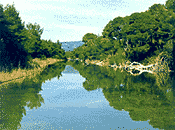 This was the site of ancient Aigai. In the hinterland, a sight worth seeing is the post-Byzantine monastery of Agia Triada (1715), which has well- preserved mosaics. Next come Platanos, Trapeza, verdant hamlets, and Diakofto. This is where the funicular railway leaves for Kalavrita.
This was the site of ancient Aigai. In the hinterland, a sight worth seeing is the post-Byzantine monastery of Agia Triada (1715), which has well- preserved mosaics. Next come Platanos, Trapeza, verdant hamlets, and Diakofto. This is where the funicular railway leaves for Kalavrita.
Continuing along the coast road, you see the roofs of one village after another poking through the unbroken green of the hillsides. Stop for a while at Egion. In this town, which is divided into an upper and a lower section, the old district near the shore is interesting; an enormous plane tree noted by Pausanias on his travels still reigns supreme. The church of the Virgin Faneromeni, built according to designs by Schiller, lies in the upper town. Just outside the town one can visit the chapel of the Virgin Trypiti, tucked into a crevice in a rock. The parade of villages continues. Longos, with its pebbly beach, Lambiri, with its lovely shore, Psathopirgos, a pretty hamlet. Each one has its special role to play, its distinguishing feature.
And all of them have a little taverna or a quaint cafe where you can relax for a while. Right before Patras comes Rio, a transportation hub, uniting the Peloponnese with Central Greece and Epiros by car ferry. Jutting towards the sea, the old Venetian fortress, the "Castle of the Morea", faded and ravaged by time, is the first thing to strike the eye. Traversing Patras, continue along the old Patras-Pirgos road.
 In 146 BC the area fell to the Romans. It embraced Christianity earlier than the rest of Greece (St. Andrew the Apostle preached in Patras and was martyred there). In 1205 it occupied centre stage with the founding of the Principality of Achaia by the Franks. Before too long it passed to the hands of the Palaiologues who ruled the Peloponnese from Mistra; they were succeeded by the Turks in 1460. For a short period (1687-1715), the area was a Venetian colony. It was liberated in 1828.
In 146 BC the area fell to the Romans. It embraced Christianity earlier than the rest of Greece (St. Andrew the Apostle preached in Patras and was martyred there). In 1205 it occupied centre stage with the founding of the Principality of Achaia by the Franks. Before too long it passed to the hands of the Palaiologues who ruled the Peloponnese from Mistra; they were succeeded by the Turks in 1460. For a short period (1687-1715), the area was a Venetian colony. It was liberated in 1828. A trip to Patras Patras is the capital of the region or prefecture. It owes its name to Patreas, chief of the Achaians. The city is among the most important in Greece, and the largest in the Peloponnese. It is also a major transportation centre, linking the country with Italy and the Peloponnese with the lonian islands.
 The city extends from the shore up to the Castle. It is divided into two parts, the upper and the lower, whose layout, parks and plazzas give it a definite distinction. The old city, at the foot of the castle, still has quite a number of attractive neoclassical houses, while the lower city has many mansions, such as those housing the Municipal Theatre, the Odeon, etc. The Cathedral of St. Andrew, the city's patron, rises majestically above the lower city. To the left of it stands an older church built on the site of a Byzantine church that was destroyed by the Turks. From here Trion Navarchon street leads to Psila Alonia - the "balcony" of Patras - a lovely spacious square with slender palm trees and a sun dial. Patras possesses a fine archaeological museum, an art gallery and a printing museum.
The city extends from the shore up to the Castle. It is divided into two parts, the upper and the lower, whose layout, parks and plazzas give it a definite distinction. The old city, at the foot of the castle, still has quite a number of attractive neoclassical houses, while the lower city has many mansions, such as those housing the Municipal Theatre, the Odeon, etc. The Cathedral of St. Andrew, the city's patron, rises majestically above the lower city. To the left of it stands an older church built on the site of a Byzantine church that was destroyed by the Turks. From here Trion Navarchon street leads to Psila Alonia - the "balcony" of Patras - a lovely spacious square with slender palm trees and a sun dial. Patras possesses a fine archaeological museum, an art gallery and a printing museum. Dominating the city from on high looms the ruined shell of the castle, whose grounds have been transformed into a park. From here you have a view of the whole city and the sea beyond. Patras' famous Carnival - a festive sampling of its citizens' imagination, humour and high spirits - attracts thousands of visitors every year. Finally, the city's innumerable pastry shops, its quiet little cafes, its wide range of tavernas, its lively streets bustling with locals, foreigners and transient travellers complete the picture of Patras, beautiful and celebrated throughout Greece.Life by the seashore The coasts of Achaia are a delightful concoction of picturesque villages, indented shores, gardens and shady trees. A treat for the eye. While the heart of Achaia may be its mountains, one cannot fail to hear its soul in the murmur of the sea.
Leaving Corinth, you take the coast road all the way to Patras. IYs more scenic than the National Road, since it's right on the water s edge. You reach Akrata, a coastal village, set in lush surroundings on a crystal clear sea.
 This was the site of ancient Aigai. In the hinterland, a sight worth seeing is the post-Byzantine monastery of Agia Triada (1715), which has well- preserved mosaics. Next come Platanos, Trapeza, verdant hamlets, and Diakofto. This is where the funicular railway leaves for Kalavrita.
This was the site of ancient Aigai. In the hinterland, a sight worth seeing is the post-Byzantine monastery of Agia Triada (1715), which has well- preserved mosaics. Next come Platanos, Trapeza, verdant hamlets, and Diakofto. This is where the funicular railway leaves for Kalavrita.Continuing along the coast road, you see the roofs of one village after another poking through the unbroken green of the hillsides. Stop for a while at Egion. In this town, which is divided into an upper and a lower section, the old district near the shore is interesting; an enormous plane tree noted by Pausanias on his travels still reigns supreme. The church of the Virgin Faneromeni, built according to designs by Schiller, lies in the upper town. Just outside the town one can visit the chapel of the Virgin Trypiti, tucked into a crevice in a rock. The parade of villages continues. Longos, with its pebbly beach, Lambiri, with its lovely shore, Psathopirgos, a pretty hamlet. Each one has its special role to play, its distinguishing feature.
And all of them have a little taverna or a quaint cafe where you can relax for a while. Right before Patras comes Rio, a transportation hub, uniting the Peloponnese with Central Greece and Epiros by car ferry. Jutting towards the sea, the old Venetian fortress, the "Castle of the Morea", faded and ravaged by time, is the first thing to strike the eye. Traversing Patras, continue along the old Patras-Pirgos road.
Kalavryta
Historical Kalavryta is the favorite place of many - mostly Greek - tourists. It is distant 190kms from Athens. The knot is at the 159kms on the national road of Athens - Patra. 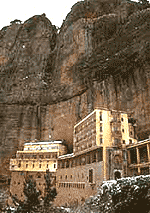 It can also be reached by rail (22kms from Diakofto) by the unique famous funicular railway crossing the renowned gorge of Vouraikos River on it?s way up. The name the town bears today dates from the Middle Ages, and derives from the words "kala vryta", meaning good springs.
It can also be reached by rail (22kms from Diakofto) by the unique famous funicular railway crossing the renowned gorge of Vouraikos River on it?s way up. The name the town bears today dates from the Middle Ages, and derives from the words "kala vryta", meaning good springs.
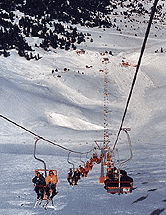 What to visit:
What to visit:
· The Monastery of Agia Lavra where the revolution of 1821 started. There you can admire the historical banner of the revolution and the heirlooms (5kms).
· The Monastery of Mega Spileon (built on a rock) where the miraculous icon of virgin Mary (one of the four icons painted by Apostle Loukas) made of wax and mastic is being kept (10kms).
· The Museum where there are among other things, a Gospel studded with diamonds, a gift of Catherine the Great, the skull of Saint Alexios, and the crozier and vestments of Bishop Yermanos.
· The Panhellenic Monument of 1821 (6kms).
· The Execution Monument where the German conquerors executed every male citizen at 13 - 12 - 43 (1km).
· The Ski Center (1600 - 2200m. altitude) at which you can take ski lessons (12kms).
· The Cave of the Lakes at Kastria which is one of it?s kind (16kms).
· The trout aquarium of Planiterou placed on the foot of mountain Helmos where you can try the tasty fried trout, fished and cooked on the spot (9kms).
 It can also be reached by rail (22kms from Diakofto) by the unique famous funicular railway crossing the renowned gorge of Vouraikos River on it?s way up. The name the town bears today dates from the Middle Ages, and derives from the words "kala vryta", meaning good springs.
It can also be reached by rail (22kms from Diakofto) by the unique famous funicular railway crossing the renowned gorge of Vouraikos River on it?s way up. The name the town bears today dates from the Middle Ages, and derives from the words "kala vryta", meaning good springs. What to visit:
What to visit: · The Monastery of Agia Lavra where the revolution of 1821 started. There you can admire the historical banner of the revolution and the heirlooms (5kms).
· The Monastery of Mega Spileon (built on a rock) where the miraculous icon of virgin Mary (one of the four icons painted by Apostle Loukas) made of wax and mastic is being kept (10kms).
· The Museum where there are among other things, a Gospel studded with diamonds, a gift of Catherine the Great, the skull of Saint Alexios, and the crozier and vestments of Bishop Yermanos.
· The Panhellenic Monument of 1821 (6kms).
· The Execution Monument where the German conquerors executed every male citizen at 13 - 12 - 43 (1km).
· The Ski Center (1600 - 2200m. altitude) at which you can take ski lessons (12kms).
· The Cave of the Lakes at Kastria which is one of it?s kind (16kms).
· The trout aquarium of Planiterou placed on the foot of mountain Helmos where you can try the tasty fried trout, fished and cooked on the spot (9kms).
City of Patras
Patras, is one of the largest working towns in the Peloponnese, and after Pireaus, the second major port in Greece. Patras is also the capital of the Archaia prefecture and owes its name to Patreas, the ancient chief of the Archaians. The region was, of course, also named Archaia after their influence.
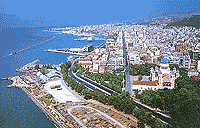 Though politically insignificant through most of antiquity, Patras started to play a more important role in 280 BC, when the Achaian Confederacy was created. In 146 BC the area fell to the Romans and later it embraced Christianity after St. Andrew the Apostle preached in Patras where he was finally martyred. In 1205, Patras occupied center stage with the founding of the Principality of Achaia by the Franks. Not too long after that, it passed into the hands of the Palaiogues, who ruled the Peloponnesse from Mistra where they were succeeded by the Turks in 1460. For a short period (1687-1715), the area was a Venetian colony and was eventually liberated in 1828.
Though politically insignificant through most of antiquity, Patras started to play a more important role in 280 BC, when the Achaian Confederacy was created. In 146 BC the area fell to the Romans and later it embraced Christianity after St. Andrew the Apostle preached in Patras where he was finally martyred. In 1205, Patras occupied center stage with the founding of the Principality of Achaia by the Franks. Not too long after that, it passed into the hands of the Palaiogues, who ruled the Peloponnesse from Mistra where they were succeeded by the Turks in 1460. For a short period (1687-1715), the area was a Venetian colony and was eventually liberated in 1828.
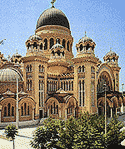 Modern Patras is one of the most important port-cities in Greece and largest of the Peloponnese. It also acts as a major transportation hub now, linking the country with Italy and the Peloponnese with the Ionian islands. The city extends from its shores up to the old Castle area and is divided into two parts: the upper castle area, and the lower with small parks and plazas that give the town a definite distinction. The Cathedral of St. Andrew is the city's patron and rises majestically above the lower city. To the left of it stands an older church built on the site of a Byzantine church that was destroyed by the Turks.
Modern Patras is one of the most important port-cities in Greece and largest of the Peloponnese. It also acts as a major transportation hub now, linking the country with Italy and the Peloponnese with the Ionian islands. The city extends from its shores up to the old Castle area and is divided into two parts: the upper castle area, and the lower with small parks and plazas that give the town a definite distinction. The Cathedral of St. Andrew is the city's patron and rises majestically above the lower city. To the left of it stands an older church built on the site of a Byzantine church that was destroyed by the Turks.
In this convenient port-city you can also go to Italy and Cyprus without hassle, as well as connect to the Ionian islands and Crete. These days, the city has become a key link to the transport network of the mainland too. In Patras you can generally find good restaurants and comfortable hotels. In February, Patras is also known for its famous Carnival, which offers a festive sampling of its citizens' imagination filled with humor and high spirits which attracts thousands of visitors every year.
The city's innumerable pastry shops, its quiet little cafes, its wide range of tavernas, its lively streets thriving with locals, foreigners and transient travelers complete the picture of Patras as a lively bustling port-center much celebrated throughout Greece.
 Though politically insignificant through most of antiquity, Patras started to play a more important role in 280 BC, when the Achaian Confederacy was created. In 146 BC the area fell to the Romans and later it embraced Christianity after St. Andrew the Apostle preached in Patras where he was finally martyred. In 1205, Patras occupied center stage with the founding of the Principality of Achaia by the Franks. Not too long after that, it passed into the hands of the Palaiogues, who ruled the Peloponnesse from Mistra where they were succeeded by the Turks in 1460. For a short period (1687-1715), the area was a Venetian colony and was eventually liberated in 1828.
Though politically insignificant through most of antiquity, Patras started to play a more important role in 280 BC, when the Achaian Confederacy was created. In 146 BC the area fell to the Romans and later it embraced Christianity after St. Andrew the Apostle preached in Patras where he was finally martyred. In 1205, Patras occupied center stage with the founding of the Principality of Achaia by the Franks. Not too long after that, it passed into the hands of the Palaiogues, who ruled the Peloponnesse from Mistra where they were succeeded by the Turks in 1460. For a short period (1687-1715), the area was a Venetian colony and was eventually liberated in 1828. Modern Patras is one of the most important port-cities in Greece and largest of the Peloponnese. It also acts as a major transportation hub now, linking the country with Italy and the Peloponnese with the Ionian islands. The city extends from its shores up to the old Castle area and is divided into two parts: the upper castle area, and the lower with small parks and plazas that give the town a definite distinction. The Cathedral of St. Andrew is the city's patron and rises majestically above the lower city. To the left of it stands an older church built on the site of a Byzantine church that was destroyed by the Turks.
Modern Patras is one of the most important port-cities in Greece and largest of the Peloponnese. It also acts as a major transportation hub now, linking the country with Italy and the Peloponnese with the Ionian islands. The city extends from its shores up to the old Castle area and is divided into two parts: the upper castle area, and the lower with small parks and plazas that give the town a definite distinction. The Cathedral of St. Andrew is the city's patron and rises majestically above the lower city. To the left of it stands an older church built on the site of a Byzantine church that was destroyed by the Turks. In this convenient port-city you can also go to Italy and Cyprus without hassle, as well as connect to the Ionian islands and Crete. These days, the city has become a key link to the transport network of the mainland too. In Patras you can generally find good restaurants and comfortable hotels. In February, Patras is also known for its famous Carnival, which offers a festive sampling of its citizens' imagination filled with humor and high spirits which attracts thousands of visitors every year.
The city's innumerable pastry shops, its quiet little cafes, its wide range of tavernas, its lively streets thriving with locals, foreigners and transient travelers complete the picture of Patras as a lively bustling port-center much celebrated throughout Greece.

